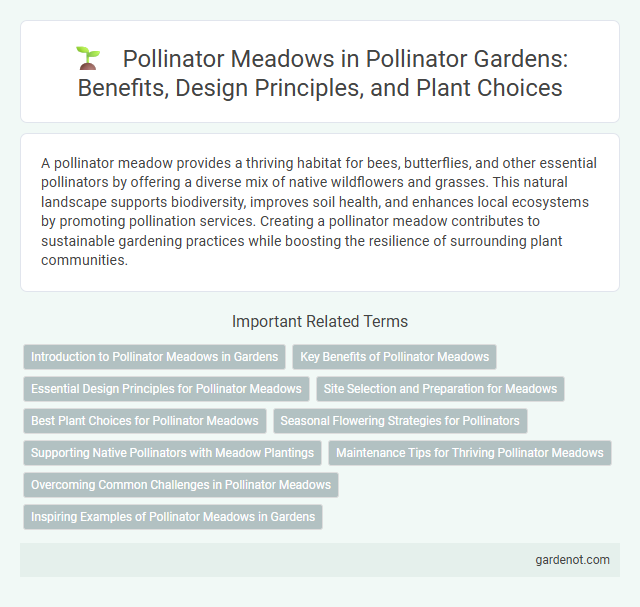A pollinator meadow provides a thriving habitat for bees, butterflies, and other essential pollinators by offering a diverse mix of native wildflowers and grasses. This natural landscape supports biodiversity, improves soil health, and enhances local ecosystems by promoting pollination services. Creating a pollinator meadow contributes to sustainable gardening practices while boosting the resilience of surrounding plant communities.
Introduction to Pollinator Meadows in Gardens
A pollinator meadow in gardens provides a diverse habitat rich in native wildflowers that attract essential pollinators such as bees, butterflies, and hummingbirds. These meadows support biodiversity, improve garden health, and enhance pollination rates crucial for fruit and vegetable production. Establishing a pollinator meadow involves selecting native plant species, ensuring continuous bloom periods, and minimizing pesticide use to create a sustainable ecosystem.
Key Benefits of Pollinator Meadows
Pollinator meadows provide essential habitats that support diverse species including bees, butterflies, and hummingbirds, enhancing local biodiversity. These meadows improve pollination efficiency for nearby crops and wild plants, contributing to healthier ecosystems and increased agricultural productivity. By offering continuous floral resources throughout the growing season, pollinator meadows help sustain pollinator populations and promote long-term environmental resilience.
Essential Design Principles for Pollinator Meadows
Pollinator meadows require diverse native plant species that bloom sequentially to provide continuous nectar and pollen sources throughout the growing season. Optimal site selection includes well-drained soil with adequate sunlight exposure, supporting the specific needs of local pollinator populations such as bees, butterflies, and hummingbirds. Incorporating structural diversity with varying plant heights and avoiding pesticide use enhances habitat quality and promotes pollinator health and biodiversity.
Site Selection and Preparation for Meadows
Selecting a well-drained site with full sun exposure is essential for a thriving pollinator meadow, as most native wildflowers and grasses require at least six hours of direct sunlight. Soil preparation involves removing existing vegetation through methods such as solarization or tilling, and testing soil pH to ensure it falls between 6.0 and 7.5 for optimal plant health. Incorporating organic matter and creating a smooth seedbed enhances seed-to-soil contact, promoting robust germination and establishment of diverse pollinator-friendly flora.
Best Plant Choices for Pollinator Meadows
Native wildflowers such as milkweed, coneflowers, and black-eyed Susans offer optimal nectar and pollen resources for pollinator meadows. Incorporating a diverse mix of flowering plants with staggered bloom times ensures continuous forage for bees, butterflies, and other pollinators throughout the growing season. Choosing region-specific, drought-tolerant species enhances meadow resilience while supporting local pollinator populations.
Seasonal Flowering Strategies for Pollinators
Pollinator meadows utilize seasonal flowering strategies to provide continuous nectar and pollen sources throughout the growing season, supporting diverse pollinator species such as bees, butterflies, and hummingbirds. Early spring bloomers like crocuses and wild violets offer essential forage for emerging pollinators, while summer-flowering plants such as milkweed and coneflowers sustain active populations during peak pollination periods. Fall-blooming species like goldenrod and asters extend foraging opportunities, ensuring pollinator health and ecosystem resilience year-round.
Supporting Native Pollinators with Meadow Plantings
Pollinator meadows rich in native wildflowers and grasses provide essential habitat and food sources that support native pollinators like bees, butterflies, and hummingbirds throughout their life cycles. Incorporating diverse meadow plantings that bloom sequentially ensures continuous nectar and pollen availability, promoting pollinator health and biodiversity. Establishing native pollinator meadows enhances ecosystem resilience and aids in the conservation of declining pollinator populations.
Maintenance Tips for Thriving Pollinator Meadows
Regularly mown paths within pollinator meadows promote healthy plant growth and reduce invasive species encroachment. Seasonal pruning of native wildflowers and grasses enhances blooming cycles, supporting diverse pollinator populations such as bees, butterflies, and hummingbirds. Incorporating organic mulch and avoiding pesticides ensures soil vitality and a toxin-free habitat essential for pollinator health.
Overcoming Common Challenges in Pollinator Meadows
Pollinator meadows face challenges such as invasive species, soil quality, and seasonal bloom gaps that can hinder pollinator support. Selecting native plants adapted to local conditions improves resilience against invasive species and supports diverse pollinator populations. Regular monitoring and adaptive management ensure continuous floral resources, fostering a thriving habitat for bees, butterflies, and other pollinators.
Inspiring Examples of Pollinator Meadows in Gardens
Pollinator meadows transform garden spaces into vibrant habitats that attract bees, butterflies, and hummingbirds, enhancing biodiversity and ecological health. Notable examples include the Xerces Society's demonstration meadow, which showcases native wildflowers like milkweed and lupine to support endangered pollinators. Gardens such as the High Line in New York City incorporate pollinator meadows to combine urban green space with essential habitat restoration, inspiring sustainable gardening practices worldwide.
Pollinator meadow Infographic

 gardenot.com
gardenot.com